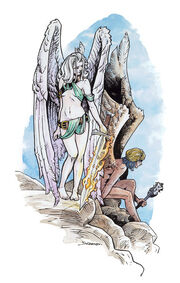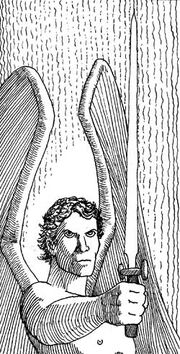Movanic devas were a kind of angel and members of one of the three orders of the devas, the others being astral devas and monadic devas. The most privileged and worldly of devas, movanic devas oversaw the Prime Material Plane, the Negative Energy Plane, and the Positive Energy Plane.[3][4][2][1]
Description

A movanic deva (with belt) and a monadic deva (without pants).
Devas appeared as human-like men and women[note 1] of extraordinary beauty or handsomeness with two magnificent feathered wings emerging from their backs. Movanic devas had lithesome frames capable of extraordinary agility, with skin of milky white hue and hair and eyes that appeared silvery.[3][4][2][1][note 2] Movanic devas stood around 6.5 feet (1.98 meters)[3][4] or 6 feet (1.8 meters) tall,[2] but particularly mighty examples could grow to much larger size.[1]
Devas were averse to clothing; when they must adhere to mortal custom, they donned simple loincloths or other coverings.[1]
In a peaceful moment, a movanic deva would adopt the shape of a humanoid or an animal.[2][1] In fact, they rarely manifested their glorious true forms, unless it suited their purposes to awe mortals.[2]
Society
The movanic devas were the weakest yet the most numerous of the devas. Nevertheless, the order of movanic devas was politically equal to the orders of astral and monadic devas, and there was no rivalry between them.[2][1] Although the orders might sometimes bicker over differences in personality, they always cooperated.[1]
Movanic devas fought as infantry in battles against the forces of darkness, and they did so with pride.[1] They were also charged with serving the needs of the Prime Material Plane, the Negative Energy Plane, and the Positive Energy Plane.[3][4][1]
The movanic devas had the privilege of traveling to the Material Plane at will to aid prominent followers of the gods of good in times of great need. While they more often appeared disguised as humanoids or animals, they could manifest in their winged angelic form if this suited their needs.[2]
They usually worked alone, but also operated in pairs, trios,[3][4][2][1] or squads of up to six members.[3][4][1]
Personality
Well-travelled in the planes and in the mortal world, and gaining a greater understanding of the affairs of mortals, some movanic devas saw themselves as more worldly than their astral and monadic kin. Nevertheless, no deva would knowingly deal peaceably with evil beings, but those of non-lawful bent sometimes dealt with neutral beings.[1] They were strong-willed and fearless.[2][1]
Possessions
Although they might use many different weapons, each movanic deva wielded a flaming two-handed sword of long and slender design, considered a flame tongue sword +1[3][4][2] or +1 flaming greatsword.[1] They had no need of any treasure or wealth, nor even clothing.[2][1]
Combat

"...and a flaming sword that turned every way to guard the way..."
Movanic devas loved battle, though not to the extent of the monadic devas. Reacting swiftly and never taken by surprise, they tended to dive into melee, with firm grips on their flaming swords.[2][1] They fought with skillful and rapid attacks.[3][4]
By parrying with their flaming sword, a movanic deva could deflect missiles and hurled weapons and counter rays and other spells that targeted them alone, even ones that were unavoidable, like magic missile. However, they had to be aware of an incoming attack to deflect it, and they could not deflect two simultaneous strikes.[2][1]
Powers
Movanic devas possessed all the powers, protections, and traits common to devas and to other angels, and many more of their own.[3][4][2][1] They were immune to injury from mundane and minor magical weapons.[3][4][2][1]
Whether with the spell polymorph self or an inherent ability to change shape, they could change their form into that of any humanoid, from halfling to human in size, or into an animal.[2][1]
With the soothing presence of nature itself, a movanic deva had a calm nature that creatures of the natural world invariably found pleasing. No animal or plant would willingly attack one, not unless compelled by magic.[1] It seemed they could not even be harmed by plant life. However, reptiles and similar creatures, and monstrous creatures, could attack them freely.[3][4]
Possessing a divine equilibrium, movanic devas were immune to the deleterious effects of planes suffused with either negative energy or positive energy, making them immune to death spells and loss of experience or life-force.[3][4][1] Whether the energy was negative or positive was all one and the same to them.[3][4]
In addition to the common spells of devas, movanic devas were also reported to cast cause or cure blindness, detect traps, and neutralize poison;[3][4] or anti-magic shell, protection from normal missiles, and spell turning, and they could use any invocation/evocation spell they wished, once a day.[2] Later, it was reported they could cast atonement, bless weapon, commune, consecrate, create food and water, cure serious wounds, daylight, death ward, divination, ethereal jaunt, hallow, neutralize poison, prayer, and protection from arrows; and raise dead.[1]
When a deva died on the Prime Material plane or the Elemental planes,[3][4] all parts of their body, what clothes they wore, their flaming swords, and their other possessions vanished completely.[1] Only their material body was destroyed, while their immortal spirit returned to their home plane. It took ten years to regain the power to manifest a corporeal form. If they died on any other plane, then they were destroyed utterly.[3][4]
Relations
Devas of all kinds were known to serve the deities Azuth, Ilmater, and Mystra, while movanic devas in particular served Deneir, Lliira, and Milil.[5][6] Another movanic deva, called the Sannyasi, served the Serene Abhirati, a goddess of the Utter East.[7][8]
A good and mighty spellcaster could briefly summon and command a movanic deva with summon monster VII, or long-term with gate or planar ally.[1]
Notable Movanic Devas
- The Sannyasi, a movanic deva, was appointed by the Serene Abhirati to watch over her realm of Langdarma in the Yehimal Mountains. He had served in this role for 10,000 years by the 14th century DR.[7][8]
Appendix
Notes
- ↑ The Monstrous Compendium Planescape Appendix for 2nd-edition D&D states that devas appeared as male humans, suggesting that they were only male. This was corrected in Warriors of Heaven, which on page 40 states that, contrary to the popular view, devas could be either gender. It explains, "Previous claims that all devas were male probably grew from the tales of explorers new to the planes who happened to see a few males and jumped to the wrong conclusion." The Monster Manual and Fiend Folio for 3rd edition only state that they appear as humans, but the Fiend Folio artwork presents the movanic deva as female, confirming that devas can be of either sex in 3e as well.
- ↑ The appearances of devas have been switched in each edition. In 1st edition, in Dragon #63, movanic devas have a rosy-coppery coloration. In 2nd edition, in Monstrous Compendium Planescape Appendix, and in 3.5 edition, in Fiend Folio, they have the silvery-white coloration previously given to monadic devas. This article uses the consistent combined description of the later 2nd- and 3.5-edition sources, and won't even get into the 5th-edition deva.
Appearances
References
- ↑ 1.00 1.01 1.02 1.03 1.04 1.05 1.06 1.07 1.08 1.09 1.10 1.11 1.12 1.13 1.14 1.15 1.16 1.17 1.18 1.19 1.20 1.21 1.22 1.23 1.24 1.25 1.26 1.27 1.28 1.29 1.30 1.31 1.32 Eric Cagle, Jesse Decker, James Jacobs, Erik Mona, Matthew Sernett, Chris Thomasson, and James Wyatt (April 2003). Fiend Folio. (Wizards of the Coast), pp. 55–57. ISBN 0-7869-2780-1.
- ↑ 2.00 2.01 2.02 2.03 2.04 2.05 2.06 2.07 2.08 2.09 2.10 2.11 2.12 2.13 2.14 2.15 2.16 2.17 2.18 2.19 2.20 2.21 2.22 2.23 Allen Varney, ed. (June 1994). Planescape Monstrous Compendium Appendix. (TSR, Inc.), pp. 6–7. ISBN 978-1560768623.
- ↑ 3.00 3.01 3.02 3.03 3.04 3.05 3.06 3.07 3.08 3.09 3.10 3.11 3.12 3.13 3.14 3.15 3.16 3.17 Gary Gygax (July 1982). “Featured Creatures”. In Kim Mohan ed. Dragon #63 (TSR, Inc.), pp. 6, 7.
- ↑ 4.00 4.01 4.02 4.03 4.04 4.05 4.06 4.07 4.08 4.09 4.10 4.11 4.12 4.13 4.14 4.15 4.16 4.17 Gary Gygax (August 1983). Monster Manual II 1st edition. (TSR, Inc), pp. 42, 43–44. ISBN 0-88038-031-4.
- ↑ Julia Martin, Eric L. Boyd (March 1996). Faiths & Avatars. (TSR, Inc.), pp. 34, 54, 76, 97, 117, 129. ISBN 978-0786903849.
- ↑ Sean K. Reynolds (2002-05-04). Deity Do's and Don'ts (Zipped PDF). Web Enhancement for Faiths and Pantheons. Wizards of the Coast. pp. 10–15. Archived from the original on 2016-11-01. Retrieved on 2018-09-08.
- ↑ 7.0 7.1 Template:Cite dragon annual/1998/Rogue's Gallery: Faces of Deception
- ↑ 8.0 8.1 Troy Denning (November 1998). Faces of Deception. (Wizards of the Coast). ISBN 0-7869-1183-2.
Connections
Celestial Stewards: Deva (Astral deva • Monadic deva • Movanic deva) • Light • Planetar • Solar
